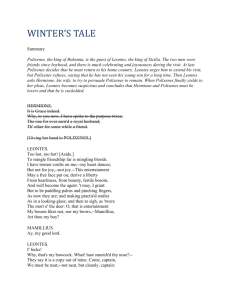The Winter`s Tale: Magic, Art, and Belief
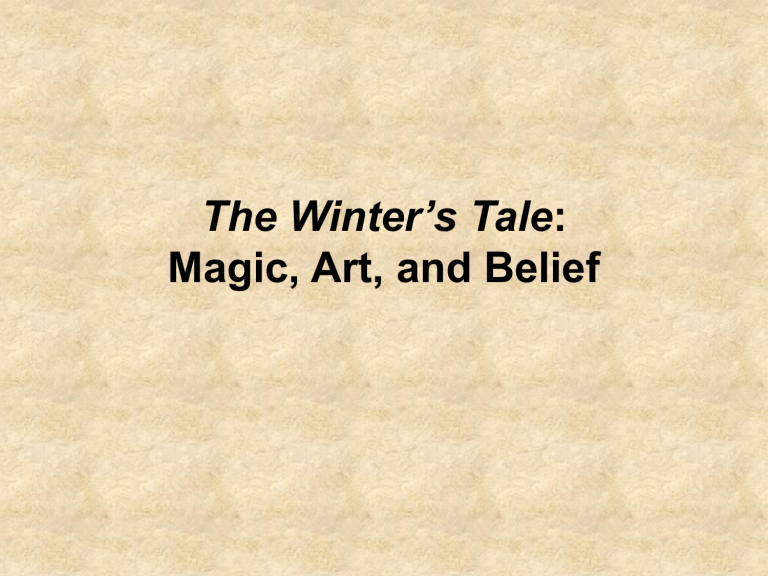
The Winter’s Tale:
Magic, Art, and Belief
The first half of The Winter’s Tale, we said, is like a tragedy, or, well, like a “winter’s tale”:
• “You have an unspeakable comfort of your young Prince Mamillius” (Arch., 1.1.35-38)
• “A sad tale’s best for winter.” (Mam, 2.1.25)
• “There was a man . . . / Dwelt by a churchyard.” (Mam, 2.1.28-31)
• “Commend it [this brat] strangely to some place, / Where chance may nurse or end it.”
(Leontes, 2.3.160, 181)
• “The Prince, your son . . . / Is dead.”
(Servant, 3.2.140-143)
• “This news is mortal to the Queen.” (Paulina,
3.2.144)
Act 5 reinvokes the idea of a “winter’s tale”:
• “The oracle is fulfilled; the King’s daughter is found; such a deal of wonder is broken out within this hour that ballad-makers cannot be able to express it. . . . This news, which is called true, is so like an old tale that the verity of it is in strong suspicion.” (2 nd Gentleman, 5.2.24-31)
• “Like an old tale still.” (re: the news of Antigones being torn to pieces by a bear) (3 rd Gentleman,
5.2.65)
• “That she [Hermione] is living, / Were it but told you, should be hooted at / Like an old tale.”
(Paulina, 5.3.115-118)
How is the notion of a “winter’s tale” different at the end of the play than in its first half?
Why is so much of the action of the final act
(the discovery of Perdita’s identity and telling of Antigones’s death, with their accompanying “proofs”; the reconciliation between Leontes and Polixenes and
Camillo; the reunion and assimilation into the Sicilian court of Perdita’s adopted father and brother, the Shepherd and his son) occur off-stage, narrated by anonymous “gentlemen”?
The On-Stage Statue of Hermione:
On first reading the play, did you think the statue of Hermione was:
A) Just a very realistic piece of art?
B) The real-life Hermione pretending to be a statue?
C) A very realistic piece of art that was magically turned into a living human being?
D) You were confused and weren’t sure what was going on.
E) None of the above.
The On-Stage Statue of Hermione:
Do you think Shakespeare’s intention and the reaction of his audience at the time to the statue scene was to see the statue as
A) Just a very realistic piece of art?
B) The real-life Hermione pretending to be a statue?
C) A very realistic piece of art that was magically turned into a living human being?
D) Confusion over what exactly was happening.
E) None of the above.
In the first act of the play, Paulina is accused by Leontes of witchcraft:
• “Out / A mankind witch!” (Leontes, 2.3.65-
66)
• “I’ll ha’ thee burned” (Leontes, 2.3.111).
In the last act of the play, the specter of witchcraft resurfaces:
• “O there’s magic in thy [the statue’s] majesty, which has / My evils conjured to remembrance, and /
From thy admiring daughter took the spirits, /
Standing like stone with thee.” (Leontes, 5.3.38-42)
• “Do not say ‘tis superstition that / I kneel [before the statue].” (Perdita, 5.3.43-44)
• “It is required/ You do awake your faith; then, all stand still. / Or those that think it is unlawful business / I am about, let them depart.” (Paulina,
5.3.94-97)
• “Start not; her actions shall be holy / As you hear my spell is lawful.” (Paulina, 5.3.104-105)
• “If this by magic, let it be an art / Lawful as eating.”
(Leontes, 5.3.110-111).
Why this preoccupation with and fear of accusations of witchcraft?
So what are we witnessing in the final scene with the statue?
A) An act of the art of witchcraft to transform and bring to life or make natural inanimate artifice.
B) An act of the power of faith in the nature of God’s grace to work miracles.
Who is the most powerful female character we have seen represented in the plays we have read this quarter?
A) Kate in The Taming of the Shrew
B) The Duchess of York in Richard II
C) Portia in The Merchant of Venice
D) Gertrude in Hamlet
E) Paulina in The Winter’s Tale

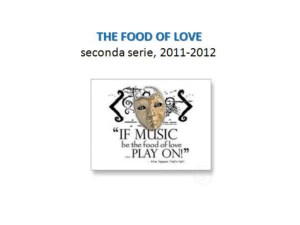

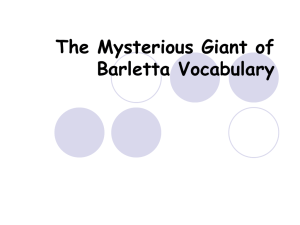
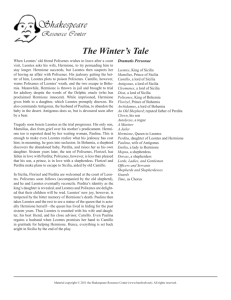
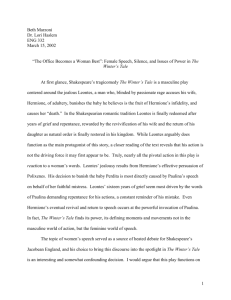
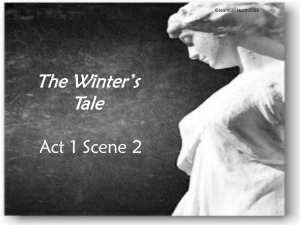
![[Gender Studies] IMAGINED REBELLION WHAT DOESN'T HAPPEN IN THE WINTER'S TALE](http://s3.studylib.net/store/data/025203067_1-f5a0922bae9e96c60a479bc4cd77e086-300x300.png)


